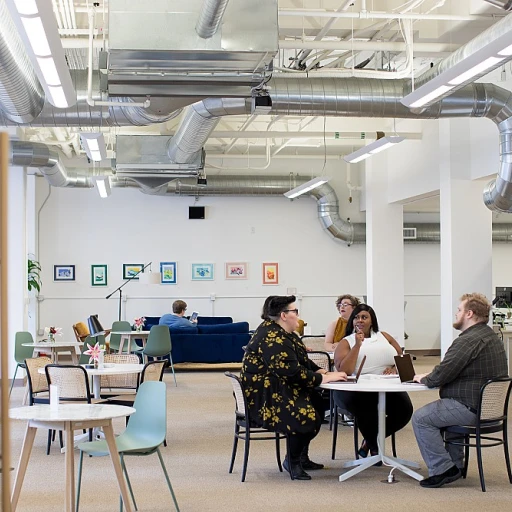
The Rise of AI in Workforce Management
The Evolution of AI in Workforce Solutions
The integration of artificial intelligence into workforce planning is not just a trend, but a transformative force that's reshaping how organizations manage their human resources. In the past, workforce planning relied heavily on manual processes and historical data, often leading to inefficient resource allocation. However, with the rise of AI technologies, these traditional approaches are being revamped and optimized to align with modern business strategies. Artificial intelligence brings with it the power to analyze complex datasets and provide insights that were previously unattainable. This capability is revolutionizing workforce management by enabling predictive analytics and real-time decision-making. The focus is shifting from reactive to proactive planning, allowing organizations to anticipate future workforce needs and allocate resources more effectively. Moreover, the integration of AI tools into workforce planning processes not only increases efficiency but also supports strategic decision-making, aligning workforce strategies with overarching business goals. As these technologies become more sophisticated, their applications will continue to expand, addressing various workforce challenges and enhancing employee engagement in HR. Businesses are increasingly turning to AI-driven solutions, paving the way for a new era of workforce planning. As we explore predictive analytics and real-time data utilization in further sections, the importance of adopting AI to overcome workforce planning challenges will become even more apparent. Embracing these advancements is not just an option but a necessity for any organization aiming to thrive in today's ever-evolving marketplace. For more insights on how AI is enhancing HR practices, explore this AI-driven tools in HR resource.Predictive Analytics: The Future of Workforce Planning
Embracing Predictive Workforce Analytics
As artificial intelligence continues to transform the landscape of workforce planning, one of its most promising applications is predictive analytics. With AI-powered algorithms, organizations can now anticipate future workforce needs with a level of accuracy that was previously unimaginable. This marks a shift from the reactive approach of the past to a proactive strategy that empowers businesses to plan ahead strategically. Predictive analytics utilizes historical data, employee performance metrics, and external market trends to forecast future workforce requirements. This allows companies to identify potential talent gaps and prepare for them, ensuring they have the right skills available when needed. In essence, AI is enabling HR professionals to move from just-in-time hiring to just-in-time workforce planning. Moreover, these advanced analytics tools assist in understanding the potential impact of different variables on workforce needs, such as economic changes, shifts in industry demands, or upcoming projects. By anticipating these factors, organizations can better allocate resources and manage their talent pool more effectively. The implementation of predictive analytics in workforce planning also paves the way for more tailored talent development programs. By identifying skills that will be in demand, HR departments can focus their training efforts on upskilling or reskilling employees, promoting internal growth, and enhancing employee engagement. This not only aligns the workforce with future business objectives but also fosters a culture of continuous learning and development within the organization. In summary, embracing predictive workforce analytics through AI not only equips businesses with the foresight needed to navigate the complexities of workforce planning but also lays the groundwork for a more agile and adaptable workforce. This technological advancement underscores the shift toward a smarter, data-driven approach in human resources management, moving beyond traditional forecasting methods to create a dynamic and responsive business environment.Real-Time Data: Making Informed Decisions
Utilizing Real-Time Insights for Strategic Choices
In the rapidly evolving landscape of modern business, the ability to make swift, data-driven decisions is not just a competitive advantage—it’s a necessity. Artificial Intelligence has ushered in a transformative era in workforce planning by enabling real-time data insights that empower organizations to make more informed decisions. One of the core benefits of incorporating AI into human resources is the continuous flow of real-time data. This data assists companies in understanding workforce dynamics with unprecedented clarity. When equipped with these insights, HR professionals can not only predict future staffing needs but also react promptly to immediate challenges. HR teams are now able to monitor trends in workforce productivity, satisfaction, and even potential turnover in real-time. This allows organizations to swiftly address emerging issues before they escalate, leading to strategic interventions that enhance overall performance and workforce stability. For more on how artificial intelligence is revolutionizing human resources, the AIHR Institute provides an insightful read. However, it is not just about data collection; it’s about making that data actionable. Real-time analytics facilitate adaptive strategies in workforce management by providing insights that drive decision-making processes. By leveraging this data, organizations can optimize workforce allocation, anticipate skill shortages, and adjust to shifting business demands seamlessly. To effectively harness these capabilities, it is crucial to integrate AI-driven tools within existing HR systems. This integration not only enhances the ability to track and analyze data but also ensures the relevance of workforce strategies in meeting organizational goals. As predictive analytics shape the future of workforce planning by forecasting trends and assisting in strategic planning, having access to real-time data becomes an indispensable component of this intricate process. In conclusion, AI’s ability to provide real-time data insights is carving a new path for workforce planning, enabling businesses to stay agile, responsive, and strategic. As AI systems become more ingrained in human resources, their capacity to enhance decision-making processes is bound to grow, setting the stage for a more efficient and engaged workforce.Addressing Workforce Planning Challenges
Overcoming Obstacles in Strategic Workforce Forecasting
In the dynamic landscape of HR and talent management, AI has become a cornerstone for robust workforce planning. Nonetheless, the integration of AI into workforce planning is not without its challenges. As organizations harness these advanced technologies, it is imperative to navigate the complexities that arise during implementation. First and foremost, data quality and accessibility remain pivotal to AI's efficacy. Successful workforce planning relies heavily on clean, comprehensive datasets that AI algorithms can analyze and interpret effectively. Organizations often face issues related to data silos, legacy systems, and the sheer volume of data. Overcoming these hurdles requires concerted efforts in data integration and standardization, ensuring that AI tools receive accurate inputs for generating meaningful insights. Moreover, there is the challenge of aligning AI-driven strategies with existing workforce management systems. Many companies operate on traditional frameworks, which may clash with the innovative approaches of AI. This requires a reevaluation of current practices and a strategic shift towards adaptable systems that can seamlessly integrate AI insights without causing disruption. Another significant hurdle is the change management involved in adopting AI technologies. Employees, understandably, may have apprehensions about AI taking over certain jobs or altering the workspace dynamics. It is crucial to implement programs that foster a culture of transparency, communication, and education about how AI serves as a tool to augment human capabilities rather than replace them. Cultivating a supportive environment can ease the transition, ensuring employee engagement and acceptance. Lastly, regulatory and compliance issues come into play when using AI for workforce planning. Organizations must be vigilant about abiding by data protection laws and maintaining ethical standards while deploying AI systems. HR professionals must stay informed about the evolving legal landscape and ensure their AI applications are compliant, safeguarding both employee data and organizational integrity. Addressing these challenges head-on by devising strategic frameworks and adopting a proactive approach can unlock the full potential of AI in workforce planning. Through careful planning and execution, organizations can transform obstacles into stepping stones towards a more efficient and informed future.AI and Employee Engagement: A New Era
The Intersection of AI and Employee Satisfaction
As workforce planning evolves with AI's integration, a vital area of focus remains employee engagement. Human resources professionals recognize that maintaining a robust connection with employees is indispensable for any company's success. While earlier sections have highlighted AI's role in workforce management and predictive analytics as catalysts in making strategic decisions, their impact extends into fostering a more engaged and motivated workforce.
AI tools can now analyze employee feedback, interactions, and performance data in unprecedented detail. This enables HR departments to identify potential issues ahead of time and tailor engagement strategies to the unique needs of their workforce. By interpreting patterns in employee sentiment through natural language processing, companies can gain insights into overall morale and address concerns proactively.
Personalized Employee Experience
Incorporating AI in workforce planning also allows for creating personalized employee experiences. From onboarding tailored to an individual's learning style to professional development programs aligned with specific career aspirations, AI empowers companies to cater to personal preferences, leading to higher employee satisfaction and retention rates. This attention to personalized experiences goes beyond mere job responsibilities, enhancing the overall work environment and making employees feel valued and understood.
Balancing Automation and Human Touch
However, as we delve into AI's capabilities to boost employee engagement, it's vital to maintain a balance between automation and the irreplaceable human touch. AI can facilitate insights and streamline processes, but the human aspect of empathy, understanding, and direct personal connection must continue to be a core element of HR practices. The challenge lies in leveraging AI tools while preserving the human connection that defines a company's work culture.
In nurturing this balance, organizations are setting the stage for a new era in which AI enhances, rather than replaces, the human interactions employees value most. This era promises a future where workforce planning and employee engagement go hand in hand, driving the organization toward holistic growth and sustainability.











